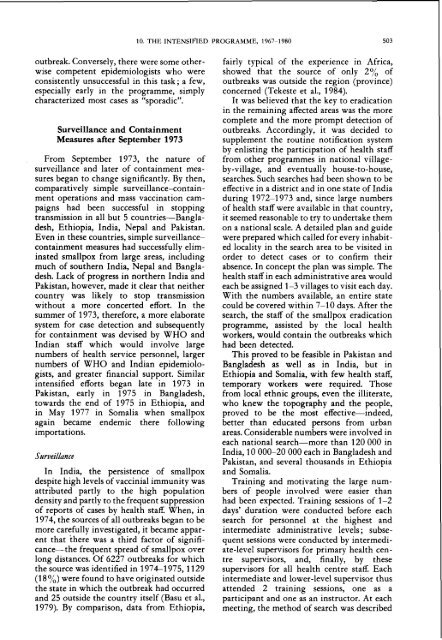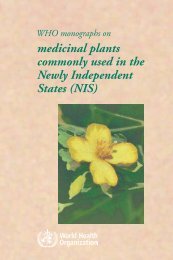smallpox eradication - libdoc.who.int - World Health Organization
smallpox eradication - libdoc.who.int - World Health Organization
smallpox eradication - libdoc.who.int - World Health Organization
Create successful ePaper yourself
Turn your PDF publications into a flip-book with our unique Google optimized e-Paper software.
10. THE INTENSIF'IED PROGRAMME, 1967-1980 503<br />
outbreak. Conversely, there were some otherwise<br />
competent epidemiologists <strong>who</strong> were<br />
consistently unsuccessful in this task; a few,<br />
especially early in the programme, simply<br />
characterized most cases as "sporadic".<br />
Surveillance and Containment<br />
Measures after September 1973<br />
From September 1973, the nature of<br />
surveillance and later of containment measures<br />
began to change significantly. By then,<br />
comparatively simple surveillance-containment<br />
operations and mass vaccination campaigns<br />
had been successful in stopping<br />
transmission in all but 5 countries-Bangladesh,<br />
Ethiopia, India, Nepal and Pakistan.<br />
Even in these countries, simple surveillancecontainment<br />
measures had successfully eliminated<br />
<strong>smallpox</strong> from large areas, including<br />
much of southern India, Nepal and Bangladesh.<br />
Lack of progress in northern India and<br />
Pakistan, however, made it clear that neither<br />
country was likely to stop transmission<br />
without a more concerted effort. In the<br />
summer of 1973, therefore, a more elaborate<br />
system for case detection and subsequently<br />
for containment was devised by WHO and<br />
Indian staff which would involve large<br />
numbers of health service personnel, larger<br />
numbers of WHO and Indian epidemiologists,<br />
and greater financial support. Similar<br />
<strong>int</strong>ensified efforts began late in 1973 in<br />
Pakistan, early in 1975 in Bangladesh,<br />
towards the end of 1975 in Ethiopia, and<br />
in May 1977 in Somalia when <strong>smallpox</strong><br />
again became endemic there following<br />
importations.<br />
Surveillance<br />
In India, the persistence of <strong>smallpox</strong><br />
despite high levels of vaccinial immunity was<br />
attributed partly to the high population<br />
density and partly to the frequent suppression<br />
of reports of cases by health staff. When, in<br />
1974, the sources of all outbreaks began to be<br />
more carefully investigated, it became apparent<br />
that 'there was a third factor of significance-the<br />
frequent spread of <strong>smallpox</strong> over<br />
long distances. Of 6227 outbreaks for which<br />
the source was identified in 1974-1 975,1129<br />
(18OlO) were found to have originated outside<br />
the state in which the outbreak had occurred<br />
and 25 outside the country itself (Basu et al.,<br />
1979). By comparison, data from Ethiopia,<br />
fairly typical of the experience in Africa,<br />
showed that the source of only 2% of<br />
outbreaks was outside the region (province)<br />
concerned (Tekeste et al., 1984).<br />
It was believed that the key to <strong>eradication</strong><br />
in the remaining affected areas was the more<br />
complete and the more prompt detection of<br />
outbreaks. Accordingly, it was decided to<br />
supplement the routine notification system<br />
by enlisting the participation of health staff<br />
from other programmes in national villageby-village,<br />
and eventually house-to-house,<br />
searches. Such searches had been shown to be<br />
effective in a district and in one state of India<br />
during 1972-1 973 and, since large numbers<br />
of health staff were available in that country,<br />
it seemed reasonable to trv to undertake them<br />
on a national scale. A detailed plan and guide<br />
were prepared which called for every inhabited<br />
localitv in the search area to be visited in<br />
order to detect cases or to confirm their<br />
absence. In concept the plan was simple. The<br />
health staff in each administrative area would<br />
each be assigned 1-3 villages to visit each day.<br />
With the numbers available, an entire state<br />
could be covered within 7-10 davs. After the<br />
search, the staff of the <strong>smallpox</strong> <strong>eradication</strong><br />
programme, assisted by the local health<br />
workers, would contain the outbreaks which<br />
had been detected.<br />
This proved to be feasible in Pakistan and<br />
Bangladesh as well as in India, but in<br />
Ethiopia and Somalia, with few health staff,<br />
temporary workers were required. Those<br />
from local ethnic groups, even the illiterate,<br />
<strong>who</strong> knew the topography and the people,<br />
proved to be the most effective-indeed,<br />
better than educated persons from urban<br />
areas. Considerable numbers were involved in<br />
each national search-more than 120000 in<br />
India, l0 000-20 000 each in Bangladesh and<br />
Pakistan, and several thousands in Ethiopia<br />
and Somalia.<br />
Training and motivating the large numbers<br />
of people involved were easier than<br />
had been expected. Training sessions of 1-2<br />
days' duration were conducted before each<br />
search for personnel at the highest and<br />
<strong>int</strong>ermediate administrative levels; subsequent<br />
sessions were conducted by <strong>int</strong>ermediate-level<br />
supervisors for primary health centre<br />
supervisors, and, finally, by these<br />
su~ervisors for all health centre staff. Each<br />
<strong>int</strong>ermediate and lower-level supervisor thus<br />
attended 2 training sessions, one as a<br />
participant and one as an instructor. At each<br />
meeting, the method of search was described
















